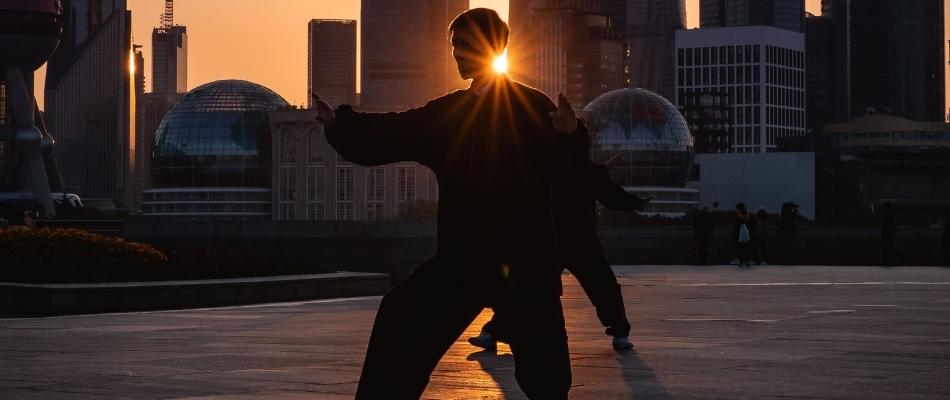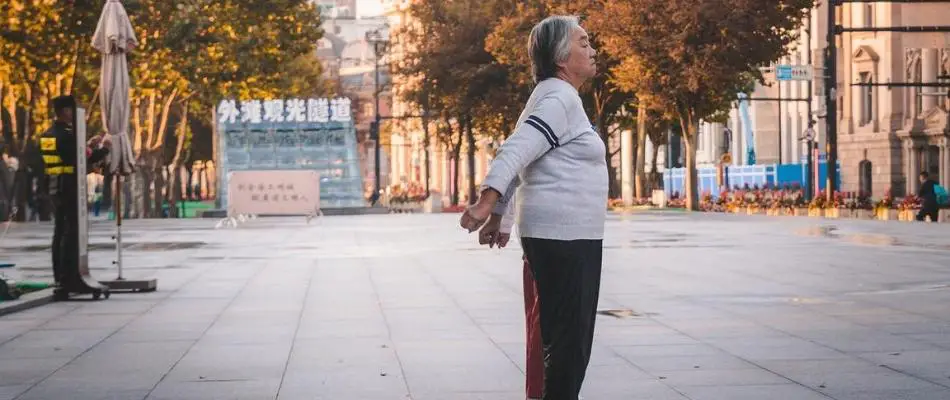There are just a tiny number of sports and physical activities that can be done your whole life. I am very jealous of the golfers, swimmers, and tennis players out there who chose sports that are lifelong events. I would probably hurt something at this point if I tried to learn golf or tennis and would not be good enough to find a partner. And while I wouldn’t drown, my swimming looks a lot like it. So that leave most people like me with walking or hiking for a lifelong passion but that can be weather permitting. And that’s why so many people are putting tai chi for seniors at the top of their list.
Few other sports have as many benefits and are as accessible as tai chi for seniors. It is an activity that can be performed throughout life and modified for energy level, mobility restrictions, and stability issues. The benefits of doing tai chi for seniors include increased strength, stamina, flexibility, mental health, and improved stability and balance.
The problem is that tai chi is not something many of us grew up with and what we see on the internet might not look like something we can do. To fix this and get us started all we need is an understanding of what tai chi actually is, knowledge about the benefits of doing tai chi to make sure it matches our goals, and then to see what the different levels or tai chi are so we know how to get started!

Dispelling the Myths About Tai Chi for Seniors
Let’s start by dispelling two big myths in the West about tai chi. Most people think that you spend your life doing the activities that you love, and when you can’t, you do tai chi. Maybe you grow up biking and then had an accident, time for tai chi! As we age and our stamina and health are reduced, then it’s time to do tai chi for seniors to “keep us active!”
Myth #1 Tai Chi is Only for Seniors
In China and other countries 4 and 6-year-old begin practice. It is a lifelong pursuit. At a younger age you might be participating in push hands competitions or doing the weapons forms. In your 20s, 30s and 40s many start to gravitate towards the regular forms and become interested in the history, culture, and meditative aspects. Older than that you learn the form and even modify the movements to accommodate any limitations you have. As you can see, tai chi isn’t just for seniors. It actually helps you maintain physical abilities like flexibility and balance or restore them.
Myth #2: Tai Chi Exercises for Seniors Are Great Because They Are Easy
The truth is that tai chi is modifiable. If you need to be in a chair, no problem. Have low stamina? Shorten the number of movements. But tai chi is not easy. If it was, you would not get the benefits people are raving about. You have to memorize and perform a series of 8-24 postures for the short form. This really taxes the brain mentally in a good way. You have to hold an upright posture in a stance without the knees or legs being locked. This is fatiguing but is also how you regain balance, reduce falls, and gain leg strength.
What I want to convey is that there are so many benefits of tai chi for seniors and it can be done by nearly everyone. It’s something that is fun to do and something that I have been proud of doing at all my ages. It’s not a last resort.

The Benefits of Tai Chi for Seniors
The benefits of tai chi for seniors fall into three main categories. There are physical health benefits which is why most people are interested in learning tai chi. But after starting, they are happy to experience the many mental health benefits of tai chi. These are both on the cognitive side such as thinking more clearly and also on the mental health side such as feeling better and having a more positive outlook on life. Lastly, and this isn’t unique to tai chi but a nice addition, there are socialization benefits and feeling connected.
Physical Health Benefits of Tai Chi for Seniors
I am going to allow my opinion to be felt in this section because I believe that there is no better activity for people over 50 or 60 than tai chi. I have seen too many people heal past injuries, get mobile, regain lost abilities that most people take for granted like walking a long distance, the flexibility to move around their house and do things like tie their shoes without thinking about it.
People who have not faced a serious health challenge or who have not lost some aspect of their physical health have no idea what I am talking about here. Many students come to tai chi to get “better.” This can mean happy, faster, stronger, more focused… But just as many come to tai chi to maintain their current level of strength or get back to how they were right before a diagnosis, injury, or weight gain. This really differentiates choosing between any other activity and tai chi for seniors. “Seniors” respect how precious the small things in life are and are able to enjoy their day in an infinite number of ways.
Improved Balance and Stability
One of the groups that have benefited from tai chi the most are adults who are using tai chi for balance and stability improvements. Tai chi focuses heavily on improving your posture while standing and moving and correctly orienting your pelvis so that is not tilted forward, reducing the mobility of your spine and causing you to lean forward. Retaining stability is a top priority for seniors considering that a CDC fall prevention study that included 20 years of research found that it is the highest cause of mortality and further injury.
Our findings demonstrate that Tai Chi exercise has a significant protective effect on fall risk among older adults.
Effect of Tai Chi Exercise on Fall Prevention in Older Adults: Systematic Review and Meta-analysis of Randomized Controlled Trials
Increased Flexibility
Flexibility directly correlates with independence. Our ability to reach, stretch, and squat dictates how we navigate our homes. For many of us these are the tasks that we take for granted such as tying our shoes or navigating the cupboards in our kitchen to cook a meal. Flexibility is something we want to restore or retain for as long as possible.
75% of tai chi research on strength and flexibility showed significant improvement in grip strength and 71.4% of papers in flexibility.
Analysis of the Effects of Tai Chi on Muscle Strength and Flexibility
Increased Stamina
There is the ability to do something and then there is the ability to do something for a sustained period. This can include walking a distance, climbing stairs, standing, or greater physical activity like golfing 18 holes. Considerations for our stamina influences what vacations we go on and which events we attend.
This study on fitness in older adults did a kind of neat thing where it evaluated what influenced physical fitness and found stamina to be one of six “first-order” factors including: Strength, Walking, Balance, Flexibility, Stamina, and Manual Speed.
Maintenance of Strength
All humans lose skeletal muscle as we age (sarcopenia) and it is pretty easy to understand that a loss of strength reduces our freedom. On top of that, research shows that muscle weakness can make us more susceptible to age-related conditions:
The consequences of sarcopenia are often severe in older adults, as the strength and functional declines associated with sarcopenia can in turn contribute to a number of adverse health outcomes, including loss of function, disability, and frailty. Sarcopenia is also associated with acute and chronic disease states, increased insulin resistance, fatigue, falls, and mortality. Of the chronic disease states, sarcopenia has been especially associated with rheumatologic conditions, especially rheumatoid arthritis in women.
Sarcopenia in older adults
Muscle maintenance should be a goal of all adults and can be obtained just by adopting an active lifestyle that challenges you. We aren’t even looking to put on a ton of muscle but simply retaining the strength that we have would be nice. Tai chi class can be taxing in a really healthy way as we are standing in bent-leg postures and moving for 30-90 minutes. Tai chi shouldn’t be misconstrued as being wimpy. It is accessible to everyone but can also be a great workout such as with standing meditation and weapons practice.
Better Health Markers
Most of the well-funded studies on tai chi for seniors have been working to see if tai chi has positive effects on the greatest health challenges to most westerners. Specific studies on blood glucose levels, blood pressure, arthritis, and stress all show that tai chi improves these numbers and is really successful when done in combination with many of the drug treatments and dietary changes.
Improved Mental Health and Outlook
Our outlook on life and how happy we are is intrinsically tied to our emotional and physical wellbeing. With tai chi, I like to divide mental health benefits into aspects of thinking such as cognitive abilities and aspects of feeling such as our mood.
Mental Health Benefits – Mood
For many people it is a pretty big leap to go from moving in a choreographed pattern to seeing improvements in our state of mind or level of worry. But know that many tai chi practitioners see reduced levels of depression, anxiety, and an improved outlook on life. A lot more time is needed to understand how this is possible. That’s why I wrote separate essays on depression, mental health, and anxiety.
Cognitive Benefits
Tai chi is a series of movements that require concentration, memorization, and the ability to follow complex directions. All of this combines to retain or improve cognitive skills. Add to this improved blood flow and oxygenation and you are thinking more clearly.
Seniors Benefit from Tai Chi’s Social Aspects
When we are talking about social benefits of tai chi we are talking about socialization or society in the truest sense of the word. There is a unity you feel at the individual level just for taking up this new hobby. By getting online to watch tai chi videos for seniors, participating in forums, or reading about internal energy, history, or whatever interests you, it’s easy to see you are part of something greater. Even when you are practicing alone you are thinking about how it will make your participation in the next class better.
Tai chi class is fun. It’s that simple. People meet before class, joke around, and then stretch and work out communally. On most nights in the second half of our class we break into groups depending on how many moves you know, and those smaller groups form friendly clusters and practice together. Class is a social event.
Lastly, you are plugging into a global community of millions of practitioners who have been working to improve their life through tai chi for hundreds of years. This is easiest to feel at cultural events, workshops or World Tai Chi Qigong Day but seniors who do tai chi are all participating in something greater.
Even during the pandemic, when everyone was feeling more isolated than ever, classmates at our school were more hungry for interaction probably because it was more limited in other areas of their life. Many reached out to me more than they did during regular class. We shifted gears with the curriculum and taught a nine-week course on standing meditation and qigong where people followed along. Then everyone turned their cameras on at the end to ask questions and chat.
Secondly, class members organized tai chi practice sessions at a park where everyone social-distanced to an extreme taking up a huge grassy area. It was certainly odd following along with people so many feet away wearing masks, but on the other hand, how many other sports could continue like this?
Tai Chi Exercises for Seniors
So how do we get started? There are plenty of tai chi exercises for seniors that are available online and probably in your town. I will share some of my favorite but what I want to do with our time here is talk about beginning tai chi for seniors because not a lot of people are focusing on how to modify the form and class so that everyone can get started. For some of my students, finishing a 90 minute class is their first goal.
Firstly, know that all tai chi forms and classes can be modified to:
- Reduce the amount of time
- Reduce the number of movements
- Reduce the type of movements
- Reduce the amount of time you are standing
- Complete the movements while seated
Not all tai chi exercises for seniors are alike because they don’t take into account the limitations of the individual. If you can’t bend over for example, eliminate bending exercises until your flexibility improves. If you have reduced stamina, sit for part of the class, do the form in sections, or just do a shortened version of the form. You will still receive many of the benefits from tai chi and can work up to longer or more challenging parts.
Seated Tai Chi for Seniors
Yes! Beginning tai chi for seniors can be seated. There have even been specific forms that have been devised for the Olympics and for people who use wheelchairs.
There are some important points I want to make about doing seated tai chi so that you get the most out of it. First, posture is still your most important consideration. You should be erect and pushing up from your tailbone through the crown of your head. This can be exhausting if you don’t have strong core muscles but they will strengthen over time.
If you are interested in doing seated tai chi, then you need to check out David Dorian Ross. He has been producing great tai chi videos for seniors both on YouTube and as instructional videos.
Recorded and Live Tai Chi Classes for Seniors
There are also an infinite number of ways to learn tai chi as you graduate up or stay with the standing form. You can can attend a live class in your town, buy one of many tai chi DVDs for seniors, or follow along on YouTube.
Finding a Tai Chi Class for Seniors Near You
All tai chi classes for seniors are different. Call ahead or just go for a visit. The big question is, are their other people who look like you in the class? If not, don’t worry. Tai chi communities are usually friendly and tight-knit. Tell the instructor what you are looking for and ask if anyone else teaches tai chi for seniors in town. I routinely get this question and I suggest other great instructors in town.
Finding Tai Chi DVDs for Seniors
There are so many options when you are looking for tai chi videos for seniors and more coming out each day. The best way to see this is to search online for top rated tai chi DVDs for Seniors. Read the reviews and make sure people that are giving feedback are your same age or are looking to make the same improvements.
Tai Chi for Seniors on YouTube
Lastly, there are also tons of videos related to tai chi for seniors on YouTube. This is a great place to start if you are new to tai chi and just want to try it out but I am going to suggest that you don’t use these videos if you are serious about making progress.
The problem is that many people have taken portions of the tai chi form, put them in a different order, or no order at all. In essence, it is tai chi but has lost most of the benefits that you get from learning from an instructor. YouTube tai chi for seniors videos are a great free option to wrap your mind around it but for just a few bucks you can get a video that can teach you an entire set that you are more likely to benefit from. I love YouTube because it has introduced so many people to tai chi. I have new class attendees all the time saying they came to class to try it out after having started by following a tai chi video on YouTube. Almost always they say something like; “Oh, this is what we were supposed to be doing” or “Oh, this is why we are doing that move.” The meaning or purpose could not be conveyed in the snippets they were watching.
No matter what you do, try tai chi! It can be free at the beginning and can be modified for everyone. The benefits of tai chi for seniors are too great to not give it a shot.



Would like to publish your article on our website www.woodlandstaichi.com